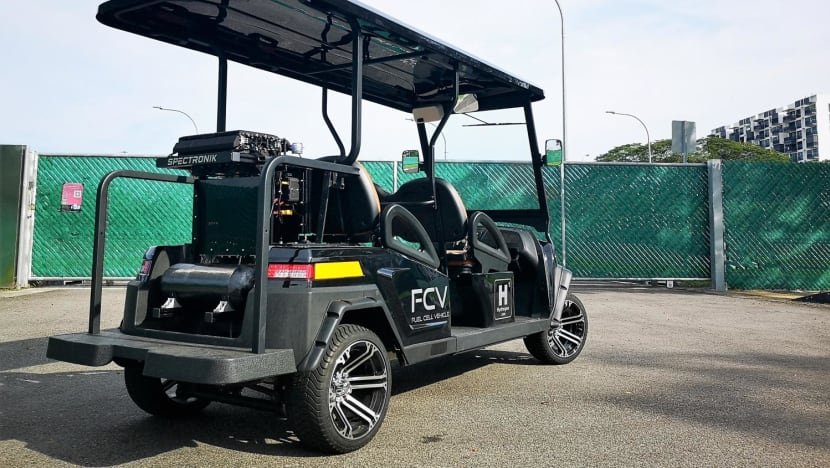Is hydrogen the key to sustainable transport?
Energy demand and prices are rising and so is the pressure to find sustainable energy sources for industry and transport. Money Mind finds out if hydrogen is a viable solution.

A hydrogen fuel cell powered buggy. (Photo: Twitter/Spectronik)
SINGAPORE: Hydrogen fuel cells are zero-emission power generators that use the chemical energy of hydrogen to produce electricity.
Electricity, heat and water are the only products.
Compared to lithium batteries, hydrogen fuel cells contain about three times more energy. This means that vehicles can run three times longer. Also, refuelling the hydrogen tank is fast – taking a matter of minutes, compared to several hours for a battery.
Spectronik is a fuel cell solution start-up founded in Singapore in 2011. The company develops hydrogen fuel cells that can power drones, robotics, and electric vehicles.
Unlike batteries that store energy, hydrogen fuel cells generate energy. This will be a big step in the quest for a net zero carbon future.
But Spectronik CEO Jap Jogjaman is realistic about the challenges ahead.
“The fuel cell will not be the silver bullet, just like lithium batteries cannot be a one-size-fits-all solution. We are trying to reduce the technical complexity as well as the high-cost barrier to fuel cell adoption. So to solve complexity, we designed a fully integrated plug-and-play system available in different power ranges for various vehicle sizes.”
Fuel cells provide advantages over traditional combustion-based technologies, including greater efficiencies and lower emissions.
Since hydrogen fuel cells emit only water, there are no carbon dioxide emissions or other pollutants released into the atmosphere. Fuel cells are also quiet during operation as they have fewer moving parts than combustion technologies.
But not all hydrogen is the same. Most of what is provided today is grey hydrogen.
Grey hydrogen releases greenhouse gas emissions, while blue hydrogen is cleaner because its carbon is captured.
To achieve net zero, the aim is green hydrogen. This is hydrogen produced by splitting water by electrolysis. This produces only hydrogen and oxygen.
The challenge is to come up with a scaleable and cost-effective solution.
The majority of hydrogen stations worldwide charge around US$15 to US$20 per kilogramme of grey hydrogen.
Green hydrogen costs more – but that’s what is needed to achieve net zero emissions.
Looking ahead, Spectronik believes that tomorrow’s urban transport demands will diverge between batteries for passenger cars and fuel cells for fleet vehicles – which are groups of motor vehicles owned or leased by businesses, rather than by individuals or families.
It comes down to some key differences between fuel cells and batteries.
According to Mr Jogjaman, fleet vehicles typically return to a centralised depot. This means it is possible and viable to set up one hydrogen station to serve a critical mass of vehicles. This is hence a solution to one of the challenges of not having a nationwide hydrogen infrastructure.
Fleet vehicles are also highly utilised, travelling long distances in a day. They need to be on the road, and time spent charging batteries should ideally be minimised.
Private vehicles do not face such issues. They can be charged when their owners are at work, or asleep.
In addition, while fleet vehicles make up a small portion of the entire vehicle population, they emit a disproportionately large amount of carbon emissions.
Because of these different requirements, Air Liquide’s Mathieu Giard calls hydrogen “a Swiss knife” - because it can be used for many things, but cannot be used for everything.
Other challenges remain for a broader adoption of hydrogen, including it being highly flammable and difficult to store and transport.
Air Liquide is working to reduce these hurdles.
“When you electrify the world with renewable power, you need to store energy and you need to manage carbon. And that's where hydrogen is exactly at the intersection of electrification and management of the energy mix,” said Mr Giard.
He says that in the near future, hydrogen technology will become more competitive because of advancements in technology.
According to the Hydrogen Council - by 2050, 20 per cent of the world’s energy mix could be hydrogen or hydrogen-related.















